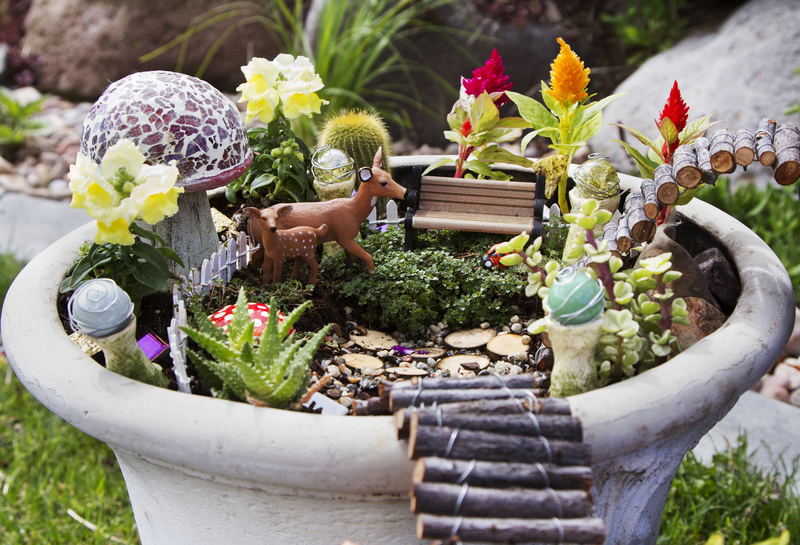Transformative Earthworks: From Waste to Soil Enrichment
Posted on 27/08/2025
Transformative Earthworks: From Waste to Soil Enrichment
In today's age of rapid urbanization and environmental consciousness, transformative earthworks have emerged as a groundbreaking practice. They are living up to their name by turning waste materials into valuable resources, enriching soils and paving the way for more sustainable landscapes. This informative article delves deep into the concept of transformative earthworks: what they entail, the process of converting waste into high-quality soil, their benefits, and tips on integrating these practices into your construction, landscaping, or agricultural projects.

Understanding Transformative Earthworks
What Are Transformative Earthworks?
Transformative earthworks refer to engineering and landscaping activities that not only alter the terrain for functional or aesthetic purposes but also emphasize recycling and upcycling waste materials to enhance soil quality. Unlike traditional earthmoving--which typically discards soil, debris, and construction waste--transformative earthworks strategically reintegrate processed waste into the land.
- Recycled organics: Food, leaf, and garden waste are converted into compost or mulch.
- Inert construction waste: Materials like concrete, brick, and glass are crushed, screened, and utilized in soil mixes.
- Industrial byproducts: Ash, gypsum, and biosolids can be responsibly processed for use in soil enhancement.
The ultimate goal is to close the loop--creating productive soils from materials that would otherwise increase landfill burden and environmental pollution.
Why Focus on Soil Enrichment?
Soil is the foundation of any successful landscape, agriculture, or restoration project. Quality soil supports healthy plant growth, improves water management, enhances biodiversity, and increases resilience to drought and erosion. However, natural soils often suffer from:
- Depletion of nutrients due to over-farming or urbanization.
- Contamination from industrial or urban waste.
- Poor structure leading to compaction and erosion.
By transforming waste into enriched soil--sometimes called waste-to-soil transformation--earthworks can kickstart the restoration of degraded landscapes and offer a sustainable solution to both waste disposal and food security.
The Transformative Earthworks Process
Executing transformative earthworks is a multi-step process that involves more than simply shifting earth around. Each phase is crucial to ensure that waste materials are turned into safe, productive soil amendments.
Step 1: Waste Collection and Assessment
The journey starts by identifying and collecting suitable waste materials. Not all wastes are appropriate for soil enrichment, and rigorous assessment is needed to exclude any harmful chemicals, plastics, or contaminants.
- Organic waste (food scraps, horticultural clippings) is particularly valuable.
- Clean construction rubble can be recycled for aggregate and soil conditioning.
- Non-toxic industrial byproducts (like gypsum) may be included in moderated amounts.
Step 2: Processing and Transformation
Transformative processing might include:
- Composting: Aerobic decomposition of organic wastes produces nutrient-rich compost.
- Screening and crushing: Hard waste materials are broken down into aggregate or fines, ideal for blending.
- Pasteurization and testing: Eliminating any harmful pathogens or seeds to guarantee safety.
This processing not only transforms the waste but improves its consistency and suitability for use as a soil amendment.
Step 3: Blending into Soil
The processed materials are then scientifically blended based on target soil characteristics, such as pH, organic matter content, nutrient balance, and drainage properties. Mixing ratios are calculated to maximize soil structure, fertility, and microbial life.
- Compost increases organic matter and soil microbiology.
- Crashed aggregates improve drainage and aeration.
- Gypsum can help break up clay soils and add calcium.
Step 4: Application and Monitoring
Finally, the enriched soil is applied to the target site--be it farmland, new development, or a rehabilitation project. Continuous soil monitoring checks for improvement in structure, plant growth, and biological activity, ensuring long-term sustainability.
Benefits of Transformative Earthworks
The transformative approach to earthworks offers distinct advantages compared to traditional waste disposal and soil management techniques:
Environmental Sustainability
- Reduces landfill pressure by diverting organic and inert wastes.
- Cuts greenhouse gas emissions through controlled composting and soil carbon sequestration.
- Preserves natural resources by reducing mining of new aggregates or topsoil.
Economic Efficiency
- Lowers disposal costs by reusing on-site or locally-sourced waste materials.
- Reduces spending on imported soil and fertilizers.
- Creates local jobs in material sorting, processing, and soil production.
Enhanced Land Productivity
- Boosts soil fertility with higher nutrient, humus, and microbial content.
- Improves water infiltration and retention--critical for agriculture and landscaping.
- Restores degraded or compacted sites with tailor-made soil blends.
Biodiversity Support
- Promotes healthy soil ecosystems with increased fungi, bacteria, and invertebrates.
- Enables diverse plantings via custom soils suited to native species.
In essence, transformative earthworks offer a holistic approach to soil creation--resulting in better ecological, social, and economic outcomes.
Key Applications of Transformative Earthworks
Urban Landscaping and Parks
Urban settings often face a shortage of natural topsoil due to past construction and pollution. Transformative earthworks supply soil blends made from recycled municipal green waste, perfect for:
- Parks and playground construction
- Landscaping rooftops and urban gardens
- Green infrastructure such as bioswales and rain gardens
Agricultural Land Restoration
Depleted farmlands benefit immensely from enriched soils derived from composted waste and processed byproducts. Transformative approaches increase yields sustainably while minimizing the need for synthetic fertilizers.
Ecological Restoration Projects
Damaged habitats (such as mining sites) require engineered soils that blend recycled mineral waste with organic matter, reintroducing nutrients and structure essential for native ecosystem recovery.
Construction and Development Sites
On-site waste (e.g., excavated earth, concrete, or timber offcuts) can be processed and reincorporated, reducing haulage, disposal, and importation costs while ensuring the new soil supports healthy landscaping and infrastructure.
Challenges and Considerations
Despite the many benefits, transformative earthworks come with their own challenges:
- Quality Assurance: Ensuring all waste-derived soil amendments are safe and non-toxic requires frequent, rigorous testing.
- Regulatory Compliance: Varies by region; permits and guidelines often dictate acceptable materials and methods.
- Public Awareness: Education is key for acceptance and for countering misconceptions about "waste-based" soils.
- Technical Expertise: Custom blends need soil scientists, engineers, and environmental managers working together.
How to Start Your Waste-to-Soil Project
Whether you're a landowner, contractor, farmer, or municipal decision-maker, implementing transformative earthworks requires planning and partnership. Here's how to begin:
1. Assess Your Site and Waste Streams
Identify all potential sources of organic and inert waste on or near your project site. Evaluate their suitability with professional advice if needed.
2. Engage Qualified Professionals
Partner with soil scientists, landscape architects, and reputable waste processors experienced in transformative earthworks.
3. Develop a Custom Soil Plan
Base your blends on site analysis, target plantings, drainage needs, and long-term land use. Consider soil testing before and after application.
4. Monitor, Measure, and Adapt
Track soil performance over time with chemical and biological analyses. Be ready to adjust your waste-sourcing or process as needed to maintain soil health and regulatory compliance.

The Future of Transformative Earthworks
The principles of transformative earthworks are set to become even more critical as global cities grow and sustainable agriculture becomes essential. Several trends are propelling waste-to-soil transformation into the mainstream:
- Advancements in soil engineering and microbial inoculation to further improve revegetation and crop yields.
- Wider adoption in urban farming, green roofs, and carbon farming initiatives.
- Government incentives and green certifications boosting investment in circular soil solutions.
- Integration of digital soil mapping and remote monitoring for real-time soil management.
In short, enriching soil with what was formerly considered waste is becoming a new standard for ecological stewardship and construction best practices.
Conclusion: Embracing a Circular Soil Future
Transformative earthworks represent a revolutionary leap beyond traditional earth-moving and waste management--proving that land restoration, agriculture, and urban development can be waste-positive, closed-loop processes. With the right partnerships, technologies, and commitment to quality, waste-to-soil transformation offers resilience, productivity, and regeneration for current and future generations.
Whether for landscape architects, farmers, developers, or environmentalists, embracing transformative earthworks and the art of converting waste into soil enrichment is not just a smart move--it's a responsible path toward sustainability and prosperity.

